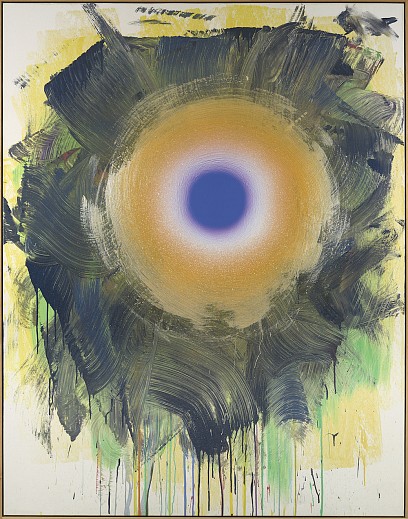
New York-Centric
May 1, 2019 - William Corwin or The Brooklyn Rail
Three canvases hang as looming, watchful presences in New York-Centric, an exhibition at the Art Students League of New York curated by James Little: Al Loving’s stolid New Hexagon (1996), Dan Christensen’s Jarrito, (1997) and Ed Clark’s sensual and lugubrious X-form Untitled (Bastille Series) (1991). While these artists, and the others in the show, fulfill Karen Wilkin’s simple precept from her introduction to the catalogue—that their paintings make “color and the way it [is] applied the main carriers of emotion and meaning”—these works, many of them contemporary but emerging from specific artists’ practices forged in the ’60s, are evidence of a decisive break with modernist tradition. They were a rejection of existing standards of aesthetics, mirroring Pop Art’s rejection of appropriate subject matter but with a more visceral turn. Loving’s marbled blue triangle illusionistically juts out into the viewer’s space, a threatening machine of sharp edges and points, while Clark’s twisting torso-like abstraction mimics the enticement of corporeal flesh. This is color not behaving itself, expanding to overtake the more modernist and Ab-Ex sanctioned notions of “gesture,” “form,” and “mark” to become the main component of painterly composition. Color was accepted historically as a tool to illuminate emotion or psychological depth, but outliers such as William Blake, Hilma af Klint, and Johannes Itten, who foregrounded color as the main dynamo of expression, were relegated to the periphery and seen as overtaxing on taste or engaged in optical trickery. Emerging mid-century, most of the artists in New York-Centric refused to handle color gingerly, and while this novel approach is not overtly political, many of the artists are African-American and several are women, and this alternative approach to abstraction may have functioned to move the form away from exclusionary art historical traditions.
This mode of abstraction predicated on hue and tint, as well as on pure monochromatic expanses of paint, quickly led to the emergence of new forms of painting. Fields of vibrant tone and simmering pigmentation cycle through our emotional responses chaotically or methodically as artists use ethereal coalescing of color. Ronnie Landfield’s Radical Light (1996) posits diffuse stains against more substantial accumulations, while curator James Little’s hard-edged procession of parallelograms in Royal Blood (2018), and Gabriele Evertz’s Chromatics + Metallics (Green) (2014) and Mark Zimmermann’s The Eagle has Landed (2018), cycle through a code of complementary colors, ticking off our reactions in short, almost equal bursts. Alma Thomas is represented by a gorgeous calligraphic work on paper, Untitled (1971), in which an expanse of indecipherable blue marks fill the picture plane edge to edge and obscures a glowing burst of orange in the upper lefthand corner, choking it with blurred linguistic filigree. Larry Poons, like Ed Clark, generates a fleshy mass of brushstrokes, in the case of Came and Went (2017) full of lurid purples and greens. Peter Reginato, in More Blues (2018), and Stanley Boxer, in Attentionscleavedharvestsofpast(1977), seek to create a more placid meditative reservoir of color at the center, and tweak the idea of framing by applying different pigments primarily to the edges. Color is such an emotional activator, one can see how it could be used to manipulate a viewer—not playing fair; but these artist are, for the most part, happy to manipulate. Thornton Willis’s Downtown, (2012) and Douglas Ohlson’s Marker/Tight D’arc (1987) play on chromatic imbalances and jab us with sudden bursts of orange, red, and green; while Margaret Neill, James Austin Murray, and Robert Swain play good cop, soothing the eye with monochromatic or dulcet and harmonious assemblages.
At a certain point, the center cannot hold: there is no unified style or even movement in action here, beyond a variety of innovative uses of color. New York-Centric is at heart a survey of artists from the region who have been, or were, active for the past five or six decades. They share the use of color as the primary vehicle in their painting, but in this historical show, many of the practitioners represent divergent schools of art. Others are still active, such that the works in the exhibition span half a century, offering vintage pieces from recently passed painters to works that have only just left the studio. Charles Hinman’s shaped canvases and Stewart Hitch and Bill Hutson’s symbolic paintings refuse to fall into any category. Instead, one feels as if one is standing in front of a contemporary tree diagram of human evolution, in which the branches never follow a single path or growth line, but constantly separate and move multiple directions. At some point, there was a break and James Little—an artist working from this sense of liberation to utilize ideas such as pattern, color, and optics as central themes—proves a thorough, creative, and conscientious arbiter of the participants in this moment. This break was the beneficial mutation that gave painting a new means of movement, perhaps even a pair of wings, and from that mutation sprang a multitude of various independent offspring. This exhibition is a survey of their growth.
Back to News
